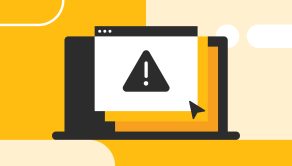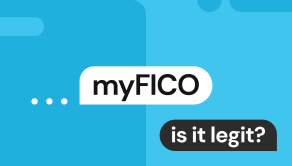USPS scam texts: how to spot and avoid fake delivery messages

“USPS: Your delivery is pending. Please verify your shipping information here: usps.delivery.info/y76382”
Would you fall for this message and click the link? If so, you just got tricked.
A USPS text scam is a fake message pretending to be sent by the United States Postal Service but in fact designed to collect your sensitive personal information. It’s a form of smishing (text-based phishing), and its only goal is to trick you into sharing your full name, home address, email, financial, and other personal details that can be exploited to steal your identity or take over your digital accounts. Scary, right?
But no need to be scared—with some knowledge of the common forms of fake USPS texts, you’ll learn to recognize them and stop scammers in their tracks. Read this simple guide on how to spot USPS text scams and avoid them successfully.
What is a USPS scam text?
USPS scam texts are fake messages that resemble official communication from the U.S. Postal Service but trick users into submitting their personal and financial information to scammers.
Scam USPS texts typically start with “USPS:” or its variations (“U S P S:,” “US Postal Service:” etc.) and then detail the reasons for the recipient to provide or verify their information, such as a shipping address, or enter their payment card details to pay a certain fee.
There are many versions of USPS fake texts circulating, but the majority of them revolve around these two major themes:
- Package awaiting action: Fake messages claiming you need to enter information or pay a customs fee to release your package that’s “temporarily detained” or that can’t be delivered just yet unless you take certain other action, like claiming your package.
- Problem with delivery: Fake messages claiming you need to verify your shipping information, or that there’s been a failed delivery attempt and now you need to pay a redelivery fee. You’ll be prompted to enter your real home address, full name and payment information.
The most common premises used by scammers are typically a package delivery missed, a problem with your mailing address, or a fee that you need to pay.
How the USPS text scam works
USPS is the largest package delivery service in the US, with millions of packages delivered daily (in 2024, it was nearly 23 million packages a day). This number gets even higher during holiday seasons. With millions of senders and recipients involved, USPS deliveries become a really convenient target for scammers, who impersonate the shipping operator to exploit people’s fallibility on a truly national scale.
Scammers don’t even need to know if you expect a delivery or not. Their tactic is to bombard anyone having a US phone number, which they can obtain through data brokers or buy on the dark web.
Under the premise of you expecting a delivery, scammers impersonate official USPS services and make you follow this common scamming algorithm:
- You get a fake message claiming you need to take action on your pending package or pay a fee to release it for further processing.
- There’s a link for you to enter your personal and/or financial information, which takes you to a spoofed website resembling the USPS site but slightly different in the URL, colors, and layout. These differences are minor and are easy to overlook.
- The website contains a form to steal your information, such as full name, home address, email, or credit card number. In the background, this site can also install malware or a keylogger on your device to continue scraping your personal information and account credentials.
Scammers can obviously benefit from stealing your credit card data, but even if they only obtain your name and address, they can still profit from it by stealing your identity or selling this information back on the dark web.
Common examples of fake USPS texts
People throughout the US report getting fake USPS text notifications, and many unfortunately fall for them.
Like in the example below, the person texts back to what is clearly a manipulation, using a phone number registered in the Philippines and spoofing the USPS website with a similar URL:
In another example of a USPS text message scam, the scammers randomly target people who might indeed expect a package from China and again use the link URL designed to resemble the USPS website, insisting on urgency so the recipient acts quickly and overlooks these discrepancies:
How to tell if a USPS text is fake
Will USPS send text messages to mail recipients at all, and how can you tell a legitimate message from a fake one? Here are the top signs that a text from USPS is a scam:
The text is unsolicited
You have no deliveries in progress, and you didn’t subscribe to text notifications from USPS. Know that USPS will only send you text messages when you explicitly opt in for USPS text tracking—either on their website or by sending a text to 28777 (2USPS) with your tracking number and a special keyword (optional) detailing what information you’d like to request.
The message contains a weird link
The phishing link URL may be disguised with a suspicious shortener or a misspelled version of the legitimate USPS domain (usps.com).
Legitimate USPS SMS messages never contain links and are only initiated by the customers themselves. If needed, you can verify or update all required shipping information on the official USPS website. You can also opt for their free Informed Delivery service to get all the details about your deliveries in progress firsthand.
It asks for a fee
No legitimate USPS message will ask you to pay for delivery or redelivery, as USPS does not charge for standard domestic redelivery or tracking services. Claiming that you have any unpaid postal charges is also a common sign of a scam text, as USPS only notifies about pending fees via physical slips or tracking updates, not SMS.
As a recipient, you may be asked to cover a customs fee or duty on an inbound international package, but the government body responsible for managing and collecting these fees is U.S. Customs and Border Protection, not USPS. You may see a notification slip attached to the delivered package specifying the customs charges due.
That said, any texts allegedly coming from USPS and claiming you owe a fee to get your item delivered or released from Customs are fake.
The sender’s phone number is from another country
USPS only sends solicited text messages requested either by you or a legitimate counterpart on your behalf (like a retailer you buy from), coming from a 5-digit short number. Fake USPS texts often come from phone numbers registered in different countries, so it helps to take a close look at where the text is coming from. Watch out for international phone codes, and don’t respond to or interact with messages that you didn’t initiate via official USPS channels.
Poor grammar, wordiness and urgency
If you look closely, you might notice that fake USPS texts are often poorly constructed, with wordy sentences and strange grammar that betray non-native speakers.
Ask yourself: would an official USPS notification contain such a lengthy explanation as, “Your USPS package is being cleared, but due to an invalid ZIP code address being detected, the package cannot be cleared”?
There’s also no reason for USPS to emphasize urgency and insist on you acting immediately, but it’s a common scamming tactic.
Here’s your checklist of signs that a USPS message is legitimate:
- It’s solicited: you initiated USPS text tracking on their official website or by texting 28777 (2USPS).
- It contains a valid tracking number related to your delivery in progress.
- It contains no links, as all the requested information is already in the text.
- It provides instructions for cancelling these texts (such as replying with STOP).
- It comes from a 5-digit short number, not a regular phone number with a foreign country code.
- It doesn’t ask you to provide any personal information or pay a delivery/redelivery fee.
What to do if you receive a suspicious USPS text
If you receive a suspicious message allegedly sent from USPS, don’t rush to respond or interact with it in any way. Pause and think: does it have the signs of a legitimate USPS message listed above?
If something looks or feels off:
- Don’t click any links.
- Block the sender.
- Report the message to USPS: send a screenshot of the message with the sender’s phone number and date visible to spam@uspis.gov, including details of your interaction with the message.
- Report the scam phone number by forwarding the text message to 7726.
If you have questions about a package you’re expecting, go to the official USPS website to track the delivery status or subscribe to the official USPS Informed Delivery service.
If you did click the link in a suspicious text and entered your personal data, even without clicking the submit button, you should contact your financial institution to alert them, change your email password, and enable two-factor authentication (preferably via a trusted authentication app, not your phone number).
How to protect yourself from USPS and other package delivery scams
According to the Federal Trade Commission, package delivery text scams, such as those impersonating USPS or UPS, were the top category among all the reported text scams in 2024. With the rise of e-commerce and the ease of sending and receiving parcels, it takes extra caution on consumers’ part to avoid falling victim to USPS impersonators.
Here’s a quick list of steps to protect yourself from smishing attacks and stay safe, whether you’re expecting a delivery now or just want to avoid USPS text scams in the future:
- Study the tips and prevention resources available on the U.S. Postal Inspection Service website.
- Remove your phone number from the internet using Onerep. The service helps identify whether your phone number and other personal information is available publicly, and sends takedown requests on your behalf, so no one can obtain this information without your consent.
- Watch out for psychological triggers in suspicious messages. Do they use urgency, fear, or scarcity to manipulate you into acting without thinking?
- Never reply to these messages or click the links they contain. Official USPS SMS messages never contain links and don’t ask for additional personal information.
FAQs
Does USPS send text messages?
Yes, USPS sends text messages, but only when requested by the customer, either via their website or by texting 28777 (2USPS). These messages will only contain the requested information along with the valid tracking number, and never ask the user to enter any additional information or pay fees.
What are top signs of scam USPS texts?
USPS scam texts typically contain a link to a spoof website that misspells or resembles the official USPS.com domain. They may ask the recipient to urgently provide personal information or to pay a fee so the package can be delivered, and they often come from a phone number registered in a different country.
What should I do if I clicked on a fake USPS link?
If you entered your financial information, contact your bank or payment card issuer for further advice. It’s recommended that you change your email password and enable two-factor authentication. You may also report the scam to the Federal Trade Commission and consider subscribing to a digital identity protection service.





Dimitri is a tech entrepreneur and founder of Onerep, the first fully automated data removal service. Top cybersecurity CEO of 2021 by The Software Report.